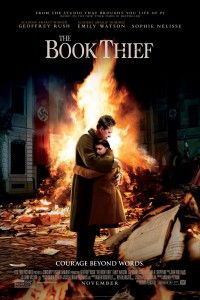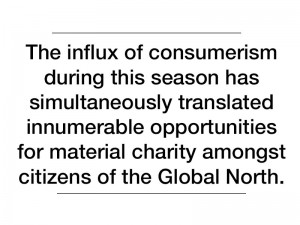Every year, shopping malls, department stores, and megastores alike are swarmed in the early hours of the morning after Thanksgiving with millions of shoppers eager to capitalize on limited-time offers on nearly everything. To me, this day embodies two very troubling conceptions of worth: the value of a sale and the value of time.
 Of the people I have talked to who go Black Friday shopping, most go not because they need anything, but because they saw an ad for something and couldn’t resist taking advantage of the great deal being offered. Or, they just go without anything in mind, and see what deals they find. I have a friend who got up at 4 a.m., went out, and purchased a flat-screen TV on Black Friday several years ago. I remember being intrigued by his purchase. I asked him why he bought it, and he simply responded, “It was on sale for only $70. Normally this TV is $200!”
Of the people I have talked to who go Black Friday shopping, most go not because they need anything, but because they saw an ad for something and couldn’t resist taking advantage of the great deal being offered. Or, they just go without anything in mind, and see what deals they find. I have a friend who got up at 4 a.m., went out, and purchased a flat-screen TV on Black Friday several years ago. I remember being intrigued by his purchase. I asked him why he bought it, and he simply responded, “It was on sale for only $70. Normally this TV is $200!”
I didn’t think much about it then, but in hindsight it strikes me that there was no real reason he had for buying that TV. You see, the rest of my conversation with my friend revealed that he hadn’t actually been looking for a new TV; he didn’t need one. But a Black Friday advertisement caught his eye and lured him right into BestBuy to get it. He may have theoretically “saved” $130 in this transaction, but in reality, he spent $70 he could have just as easily kept in his pocket. He didn’t actually save any money at all.
My friend’s story is certainly not unique. It is not uncommon to see or hear of an item on sale and think, “wow, that’s a great deal.” But when that thought isn’t followed up with something like, “do I really need it though?”, the risk is run of valuing that item more for the money theoretically saved than for its potential to enrich one’s life. This is a dangerous trap to fall into, especially habitually, and needs to be recognized.
Don’t get me wrong, I love a great deal. And I know many people have saved a lot of money on Black Friday by purchasing needed items at huge discounts. It’s not the discounts I disagree with. I simply think we tend to buy too much and spend money on things we could – and in this age of overconsumption, should – go without. We ought to at least stop to consider what kind of added value an unnecessary purchase would have in our lives, because the deal should not be the only reason we buy.
One factor we really should consider is time. Getting up early on Black Friday, scrambling through a store filled with people to then wait in line for who-knows-how-long before finally getting to finalize the sale, you might think you’ve come out on top of the whole ordeal. But is the money you save on the purchases worth several hours of stress?
Consider the value you place on your time in relation to the value of your money. I’m not saying that it’s all about time and not at all about money. I’m just saying that I think it is important for us to realize how much time we can spend in the process of making holiday purchases for the sake of saving a few bucks. There are plenty of other things we can do with our time during the holiday season. Our time is valuable, and we should hold more value in it than in pocket change.
It is easy to get wrapped up in the spirit of our society’s holiday spending sprees given the discounts offered for our taking. We are quick to be distracted by obtaining new stuff if the price is right. I wonder how much time we spend viewing holiday advertisements, shopping, or thinking about shopping. Not every moment we spend shopping and the like should be thought of as a waste, but there certainly can be excess that we should watch out for. There is a lot more in this world to see, experience, and do besides shopping for the best discounts.
So before you set out for Black Friday shopping this year, and approach the whole holiday shopping season in general, I want to challenge you to consider two things: What do you need, and how do you want to spend your time?


